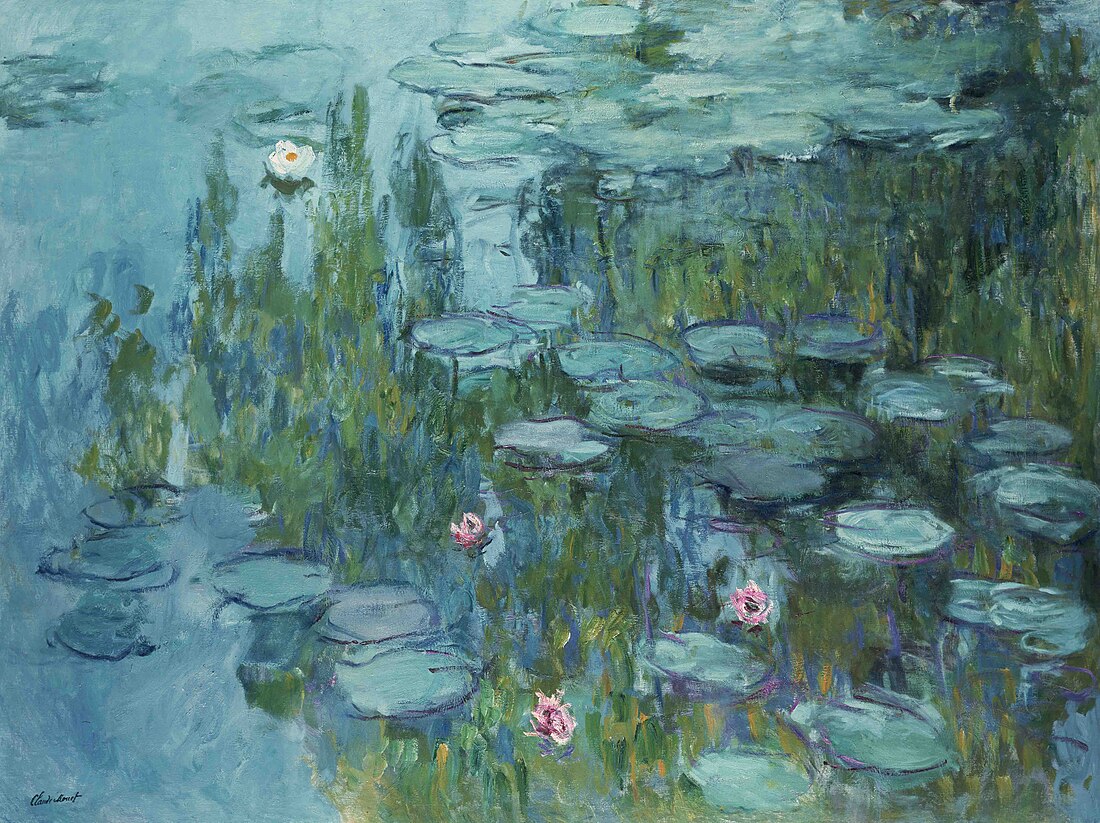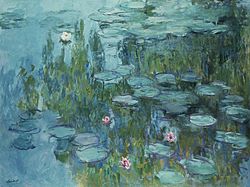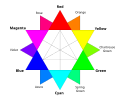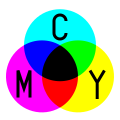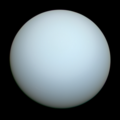Top Qs
Timeline
Chat
Perspective
Cyan
Color between blue and green From Wikipedia, the free encyclopedia
Remove ads
Cyan (/ˈsaɪ.ən, -æn/)[2][3][4] is the color between blue and green on the visible spectrum of light.[5][6] It is evoked by light with a predominant wavelength between 500 and 520 nm, between the wavelengths of green and blue.[7]
In the subtractive color system, or CMYK color model, which can be overlaid to produce all colors in paint and color printing, cyan is one of the primary colors, along with magenta and yellow. In the additive color system, or RGB color model, used to create all the colors on a computer or television display, cyan is made by mixing equal amounts of green and blue light. Cyan is the complement of red; it can be made by the removal of red from white. Mixing red light and cyan light at the right intensity will make white light. It is commonly seen on a bright, sunny day in the sky.
Remove ads
Shades and variations
Different shades of cyan can vary in terms of hue, chroma (also known as saturation, intensity, or colorfulness), or lightness (or value, tone, or brightness), or any combination of these characteristics. Differences in value can also be referred to as tints and shades, with a tint being a cyan mixed with white, and a shade being mixed with black.
Color nomenclature is subjective. Many shades of cyan with a bluish hue are called blue. Similarly, those with a greenish hue are referred to as green. A cyan with a dark shade is commonly known as teal. A teal blue shade leans toward the blue end of the spectrum. Variations of teal with a greener tint are commonly referred to as teal green.[8]
Turquoise, reminiscent of the stone with the same name, is a shade in the green spectrum of cyan hues.[9] Celeste is a lightly tinted cyan that represents the color of a clear sky. Other colors in the cyan color range are electric blue, aquamarine, and others described as blue-green.
Remove ads
History
Summarize
Perspective
Cyan boasts a rich and diverse history, holding cultural significance for millennia. In ancient civilizations, turquoise, valued for its aesthetic appeal, served as a highly regarded precious gem. Turquoise comes in a variety of shades from green to blue, but cyan hues are particularly prevalent. Approximately 3,700 years ago, an intricately crafted dragon-shaped treasure made from over 2,000 pieces of turquoise and jade was created. This artifact is widely recognized as the oldest Chinese dragon totem by many Chinese scholars.[10]
Turquoise jewelry also held significant importance among the Aztecs, who often featured this precious gemstone in vibrant frescoes for both symbolic and decorative purposes. The Aztecs revered turquoise, associating its color with the heavens and sacredness.[11] Additionally, ancient Egyptians interpreted cyan hues as representing faith and truth, while Tibetans viewed them as a symbol of infinity.[12]
After earlier uses in various contexts, cyan hues found increased use in diverse cultures due to their appealing aesthetic qualities in religious structures and art pieces. For example, the prominent dome of the Goharshad Mosque in Iran, built in 1418, showcases this trend. Additionally, Jacopo da Pontormo's use of a teal shade for Mary's robe in the 1528 painting Carmignano Visitation demonstrates the allure for these hues.[12] During the 16th century, speakers of the English language began using the term turquoise to describe the cyan color of objects that resembled the color of the stone.[13]
In the 1870s, the French sculptor Frédéric Bartholdi began the construction of what would later become the Statue of Liberty. Over time, exposure to the elements caused the copper structure to develop its distinctive patina, now recognized as iconic cyan.[12] Following this, there was a significant advancement in the use of cyan during the late 19th and early 20th centuries.
Impressionist artists, such as Claude Monet in his renowned Water Lilies, effectively incorporated cyan hues into their works. Deviating from traditional interpretations of local color under neutral lighting conditions, the focus of artists was on accurately depicting perceived color and the influence of light on altering object hues. Specifically, daylight plays a significant role in shifting the perceived color of objects toward cyan hues.[14] In 1917, the color term teal was introduced to describe deeper shades of cyan.[15]
In the late 19th century, while traditional nomenclature of red, yellow, and blue persisted, the printing industry initiated a shift towards utilizing magenta and cyan inks for red and blue hues, respectively. This transition aimed to establish a more versatile color gamut achievable with only three primary colors. In 1949, a document in the printing industry stated: “The four-color set comprises Yellow, Red (magenta), Blue (cyan), Black”. This practice of labeling magenta, yellow, and cyan as red, yellow, and blue persisted until 1961. As the hues evolved, the printing industry maintained the use of the traditional terms red, yellow, and blue. Consequently, pinpointing the exact date of origin for CMYK, in which cyan serves as a primary color, proves challenging.[16]
In August 1991, the HP Deskwriter 500C became the first Deskwriter to offer color printing as an option. It used interchangeable black and color (cyan, magenta, and yellow) inkjet print cartridges.[17] With the inclusion of cyan ink in printers, the term "cyan" has become widely recognized in both home and office settings. According to TUP/Technology User Profile 2020, approximately 70% of online American adults regularly use a home printer.[18]
Remove ads
Etymology and terminology
Its name is derived from the Ancient Greek word kyanos (κύανος), meaning "dark blue enamel, Lapis lazuli".[19][20] It was formerly known as "cyan blue"[21] or cyan-blue,[22] and its first recorded use as a color name in English was in 1879.[23] Further origins[clarification needed] of the color name can be traced back to a dye produced from the cornflower (Centaurea cyanus).[24][25]
In most languages, 'cyan' is not a basic color term and it phenomenologically appears as a greenish vibrant hue of blue to most English speakers. Other English terms for this "borderline" hue region include blue green, aqua, turquoise,[26] teal, and grue.[27]
On the web and in printing
Summarize
Perspective
Web colors cyan and aqua
The web color cyan shown at right is a secondary color in the RGB color model, which uses combinations of red, green and blue light to create all the colors on computer and television displays. In X11 colors, this color is called both cyan and aqua. In the HTML color list, this same color is called aqua, a name also used due to the color's common association with water, such as the appearance of the water at a tropical beach.
The web colors are more vivid than the cyan used in the CMYK color system, and the web colors cannot be accurately reproduced on a printed page. To reproduce the web color cyan in inks, it is necessary to add some white ink to the printer's cyan below, so when it is reproduced in printing, it is not a primary subtractive color.
Process cyan
Cyan is also one of the common inks used in four-color printing, along with magenta, yellow, and black; this set of colors is referred to as CMYK. In printing, the cyan ink is sometimes known as printer's cyan, process cyan, or process blue.
While both the additive secondary and the subtractive primary are called cyan, they can be substantially different from one another. Cyan printing ink is typically more saturated than the RGB secondary cyan, depending on what RGB color space and ink are considered. That is, process cyan is usually outside the RGB gamut,[29] and there is no fixed conversion from CMYK primaries to RGB. Different formulations are used for printer's ink, so there can be variations in the printed color that is pure cyan ink. This is because real-world subtractive (unlike additive) color mixing does not consistently produce the same result when mixing apparently identical colors, since the specific frequencies filtered out to produce that color affect how it interacts with other colors. Phthalocyanine blue is one such commonly used pigment. A typical formulation of process cyan is shown in the color box on the right.
Remove ads
In science and nature
Color of water
Cyan and cyanide
- Cyanide derives its name from Prussian blue, a blue pigment containing the cyanide ion.[31]
Oxygen
- Liquid oxygen (oxygen cooled to below −183 °C) is a clear cyan liquid.
Bacteria
- Cyanobacteria (sometimes called blue-green algae) are an important link in the food chain.[32]
Astronomy
- The planet Uranus is colored cyan because of the abundance of methane in its atmosphere. Methane absorbs red light and reflects the blue-green light which allows observers to see it as cyan.[33]
Energy
- Natural gas (methane), used by many for home cooking on gas stoves, has a cyan colored flame when burned with a mixture of air.[34]
Photography and film
- Cyanotype, or blueprint, a monochrome photographic printing process that predates the use of the word cyan as a color, yields a deep cyan-blue colored print based on the Prussian blue pigment.[35]
- Cinecolor, a bi-pack color process, the photographer would load a standard camera with two films, one orthochromatic, dyed red, and a panchromatic strip behind it. Color light would expose the cyan record on the ortho stock, which also acted as a filter, exposing only red light to the panchromatic film stock.[36][37]
Medicine
- Cyanosis is an abnormal blueness of the skin, usually a sign of poor oxygen intake; patients are typically described as being "cyanotic".[38]
- Cyanopsia is a color vision defect where vision is tinted blue. This can be a drug-induced side effect or experienced after cataract removal.
Remove ads
Gallery
- In the RGB color model, used to make colors on computer and TV displays, cyan is created by the combination of green and blue light.
- In the CMYK color model, used in color printing, cyan, magenta and yellow combined make black. In practice, since the inks are not perfect, some black ink is added.
- Color printers today use, magenta, cyan and yellow ink to produce a wide range of colors.
- Cyan and red are complementary colors in most color spaces (mixing them in equal amounts produces an achromatic color). They have a strong contrast.
- Cyan is the color of shallow water over a sandy beach. The water absorbs the color red from the sunlight, leaving a greenish-blue color.
- The dome of the Tilla Kari Mosque in Samarkand, Uzbekistan (1660) is cyan. The color is widely used in architecture in Turkey and Central Asia.
- The planet Uranus, seen from the Voyager 2 spacecraft. The cyan color comes from a combination of methane gas and atmospheric haze in the planet's atmosphere.
- A surgical team in Germany. It has been suggested that surgeons and nurses adopted a cyan-colored gown and operating rooms because it contrasts the color of red blood, thus reducing glare,[39] though the evidence for this claim is limited.
- The pigments in color photographs may degrade at different rates, potentially resulting in a cyan tint.
- While oxygen is normally a colorless gas in standard temperature and pressure, liquid oxygen is a pale cyan liquid.
Remove ads
See also
Wikimedia Commons has media related to Cyan.
References
Wikiwand - on
Seamless Wikipedia browsing. On steroids.
Remove ads
